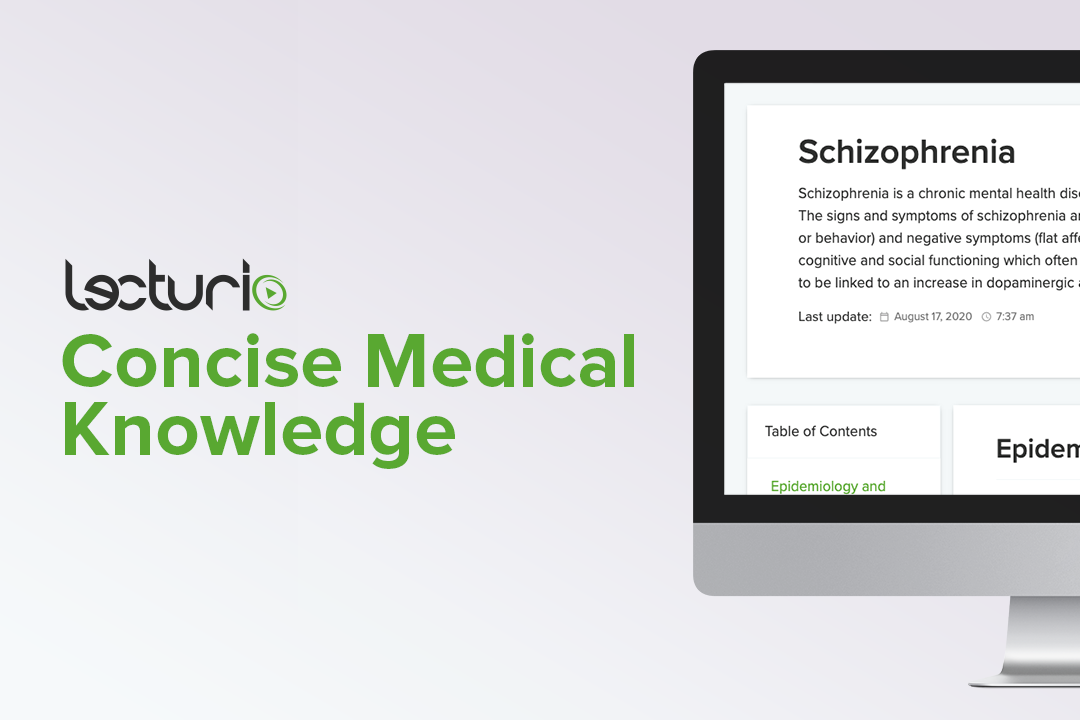Playlist
Show Playlist
Hide Playlist
Schizophrenia: Epidemiology and Pathophysiology
-
Slides Schizophrenia Psychiatry.pdf
-
Download Lecture Overview
00:01 Now, we’re going to talk about one of the most important of the psychotic disorders, which is schizophrenia. 00:08 So what is schizophrenia? It’s a psychiatric disorder characterized by a constellation of abnormalities in thinking, in motion, and behavior. 00:21 Here’s some facts about schizophrenia. 00:24 It affects approximately 1% of people over their lifetime. 00:29 Men and women are equally affected. 00:32 Men present with a disorder around 20 years of age whereas women tend to present a little bit older, around 30 years of age. 00:41 It’s very rare for someone to present with symptoms of schizophrenia before age 15 or after the age of 45. 00:52 Here’s a question for you, what season of birth is associated with higher rates of schizophrenia? Winter birth. 01:02 And there are a few thoughts about why this is. 01:06 Maybe because environmental stressors such as cold weather, nutritional deficiencies or exposure to infectious agents during this time of year occur. 01:18 There are a lot of different hypotheses in terms of the pathogenesis of schizophrenia. 01:25 The most prominent of which are the dopaminergic pathway hypotheses. 01:31 So being that there’s a disruption in either the mesolimbic pathway, which creates what we call positive symptoms of schizophrenia, the mesocortical pathway, which produces negative symptoms, the nigrostriatal pathway, which is involved in extrapyramidal symptoms and also tardive dyskinesia, or the tuberoinfundibular pathway involved in hyperprolactinemia. 01:57 We’ll go through each of these in a little bit more detail now. 02:01 The mesolimbic pathway plays a key and complex role in our motivation, emotions, reward and positive symptoms, therefore, of schizophrenia. 02:13 The mesocortical pathway is relevant to the physiology of cognition and executive function. 02:21 This is in the dorsolateral prefrontal cortex. 02:25 Emotions and affect are involved in the ventromedial prefrontal cortex and hypofunction of this pathway might be related to the cognitive and negative symptoms that are seen in schizophrenia. 02:40 The nigrostriatal pathway contains about 80% of the brain’s dopamine, a very important neurotransmitter that we think is highly dysregulated in individuals who have psychotic disorders especially schizophrenia. 02:56 The nigrostriatal pathway is involved in motor planning and dopaminergic neurons stimulate purposeful movements. 03:07 Dopaminergic projections in the tuberoinfundibular pathway influence the release of prolactin. 03:14 The dopamine is released into the portal circulation connecting the median eminence with the anterior pituitary gland. 03:23 The role of dopamine release in the tuberoinfundibular pathway is to tonically inhibit prolactin release. 03:32 And so when this pathway is disrupted, that’s why we think people get hyperprolactinemia. 03:38 Other causes of schizophrenia include the downward drift hypothesis, which is where individuals who are affected by the illness tend to follow a downward trajectory in terms of not always being very highly educated, not being able to sustain stable jobs and then basically deteriorating and drifting downward in the socioeconomic stratosphere, which then perpetuates meeting someone and producing children who are going to be more susceptible to the illness. 04:12 Other neurotransmitters that are implicated include serotonin, histamine, norepinephrine and GABA and glutamate. 04:21 You might ask why is glutamate an excitatory amino acid neurotransmitter of any interest in schizophrenia research? The answer is that the NMDA glutamate receptor is blocked by PCP and produces a clinical syndrome similar to schizophrenia including the positive and negative symptoms as well as formal thought disorder. 04:44 Here’s a question as well, what are the psychiatric indications for neuroimaging studies? You want to do neuroimaging studies such as a CT scan of the brain or MRI in any person who’s presenting with a first time psychotic episode. 05:01 Again, it’s very important to rule out medical problems. 05:05 You also want to do head imaging when somebody’s acutely confused, if there’s dementia of unknown cause, prolonged catatonia, if there’s a movement disorder of unknown origin or a personality change in someone over the age of 55. 05:22 These are all indications to do head imaging. 05:25 Another question to consider here, what is the most consistent functional neuroimaging study finding in people with schizophrenia? The answer is hypofrontality.
About the Lecture
The lecture Schizophrenia: Epidemiology and Pathophysiology by Helen Farrell, MD is from the course Schizophrenia and Thought Disorders.
Included Quiz Questions
Which of the following dopaminergic pathways is responsible for the extrapyramidal symptoms and tardive dyskinesia schizophrenic patients experience?
- Nigrostriatal
- Tuberoinfundibular
- Mesocortical
- Infundibulolimbic
- Mesolimbic
The ventromedial prefrontal cortex, part of the mesocortical pathway, is responsible for which of the following in schizophrenia?
- Emotion and affect
- Cognitive and executive functions
- Positive symptoms
- Motivation
- Motor planning
Intoxication of PCP/Angel dust produces a clinical syndrome similar to schizophrenia. Which of the following neurotransmitters is involved in this process?
- Glutamate
- Serotonin
- Epinephrine
- Norepinephrine
- GABA
Customer reviews
4,3 of 5 stars
| 5 Stars |
|
2 |
| 4 Stars |
|
1 |
| 3 Stars |
|
1 |
| 2 Stars |
|
0 |
| 1 Star |
|
0 |
Clear elaboration of dopamine pathways , I understand them better after Dr. Helen's lecture
Excellent description of psychotic disorders that is very clearly explained .
It is a simplified and organized lecture, I will definitely recommend it to my group mates.
In my opinion, she's talking a bit too slow and sounds unnatural as though she's reading a textbook. Still, the lecture is ok.




